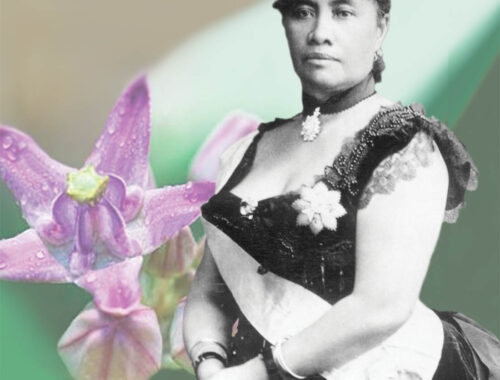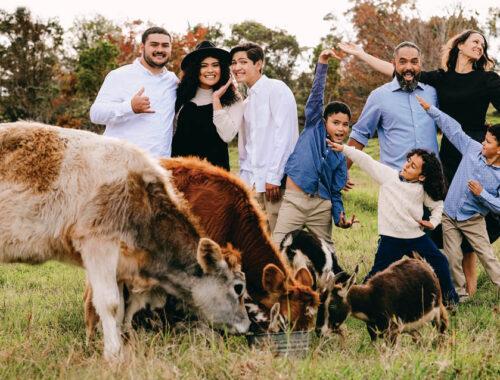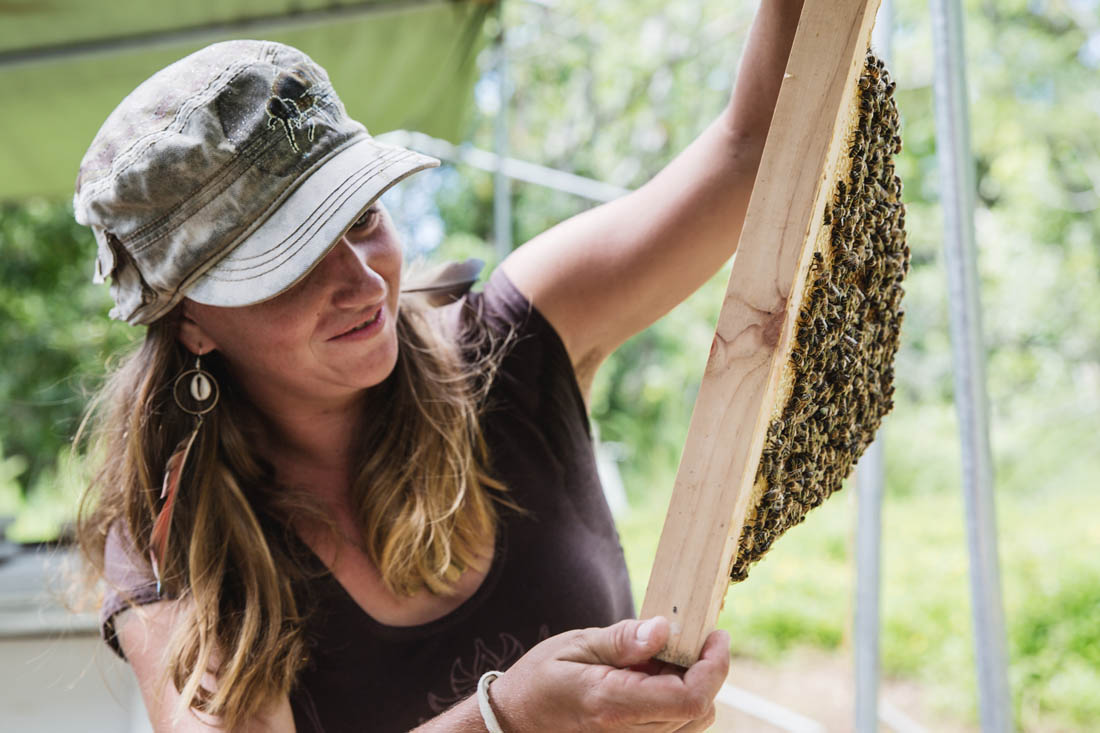
For the Love of Hawai‘i Island Beekeepers

By Stefan Verbano
Since the dawn of agriculture, honeybee keepers have braved the swarm in search of that coveted golden nectar.
The sound of an open hive is intimidating—a buzzing roar which connects with some ancient, instinctual human sense that simply yells: run! But beekeepers learn not to fear this hair-raising sound, to stand firm against the barrage of stingers, and in time they learn a sort of dance—to pull out frames, shake off bees, harvest honeycomb and restack hive boxes with a gentle, graceful yet deliberate flow.
The raw products they’re after—honey, pollen, beeswax and others—have played a vital role in the evolution of human society, their use dating back to ancient times when Egyptian pharaohs like Tutankhamun were buried in tombs lavished with, among other treasures, jars of honey.
Local Beekeeping
Hope “Bee” Anderson gives the beehive frame a firm shake and a sticky blob of honey-covered bees drips off and falls to the ground. Most of them take flight all at once, instantly exploding into a chaotic, swirling cloud of blurred yellow stripes on black. The sound of their buzzing gets louder, and the air around Hope’s backyard apiary grows thick with the swarm.
Some of the temporarily displaced bees congregate in clumps on Hope’s bare hands and arms, while others creep up her shoulders and crawl across her back. She works shirtless, so there’s no cloth to trap and panic them into stinging. To the untrained eye it would appear that Hope, the beekeeper, is running the show. She is quick to reject this notion.
“Each hive is different,” Hope says. “They all have different expressions, different ways of doing things. So, it’s really about not being in the head but coming back to the heart, because the moment I start to think that I know what I’m doing, they tell me otherwise. It’s like this constant, ‘I don’t know anything, just tell me what to do, show me the way.’”
Some of the harvested honey and beeswax will make its way into products for the company Hope founded as its “Bee Guardian.” She runs the business out of her Puna homestead—a verdant clearing in the middle of dense jungle that’s flush with planted food forests and seemingly endless bee forage. Its products include raw, hand-squeezed honey and sweetly aromatic candles made from single-filtered beeswax.
Hope sees getting more people involved in what she calls “pono [righteous] beekeeping” as a force for immense social good on Hawai‘i Island, from bolstering local food security to providing new livelihoods to creating more bountiful crop yields.
“By inviting more people to leave behind the commercial mentality and become backyard beekeepers,” she says, “we’re teaching people how to come out of their heads and into their hearts. That will have a huge impact; it’ll create more food sovereignty, and it is a cash crop. As long as we can bring awareness to the sacred and healing properties of honey, if people were more aware, there would be a huge seeking for this natural golden nectar. To make a movement like that on Big Island is impactful financially, it’s impactful on our spirit, it’s impactful on our food and on our biodiversity.”
Island Beekeepers’ Uphill Struggle
Although bees have the potential to play a leading role in a greener, healthier, and more ecologically diverse Hawai‘i Island, beekeepers today nonetheless face threats to their way of life from seemingly every corner.
A decade ago, a perfect storm of invasive bee diseases converged on the island, bringing pests like Varroa mites and small hive beetles, along with the insidious, hard-to-kill microscopic fungal parasite Nosema ceranae. Researchers estimate that these combined threats killed 55% of honeybees on the island in a single year—more than 2,500 colonies in 2010.
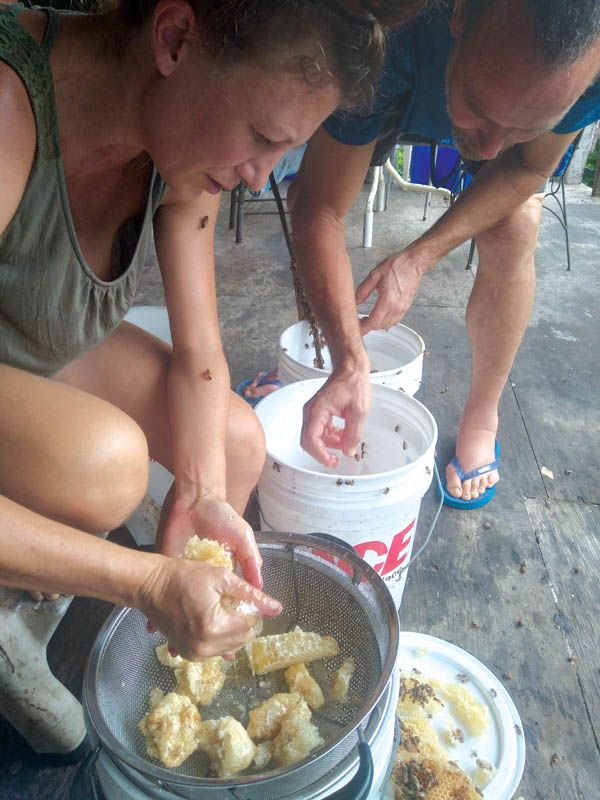
Jen Rasmussen had just started getting into beekeeping at the time, and out of the 40 hives she tended that year, she lost 36. While other beekeepers leaned into chemical pesticide-based “solutions” to control these new, devastating invaders, Jen doubled down on her own organic beekeeping practices, which she sums up in one word: hygienic.
Her methods revolve around an astonishingly simple albeit highly effective disease management technique called “checkerboarding.” This is where, during hive maintenance, a beekeeper will place an empty frame in between two already established combs, creating a sort of old-new-old-new checkerboard.
“By doing this it tells the bees that they need to make a new brood comb there to fill in the gap,” Jen explains. “It’s kind of like with humans, we change our sheets, we wash our dishes, we do these things to be hygienic.” In its simplest sense, Jen’s philosophy focuses on disease prevention rather than treatment.
“That’s what chemical beekeeping is all about; treating the symptom, not the cause,” Jen says. “And my beekeeping aspect is all about foresight—all about cause. What is it that I’m trying to avoid from happening rather than how do I deal with it once I have it? That’s what made it easier for me to deal with the kinds of things that got introduced to our area.”
Tragedy struck again several years later when Jen’s bee farm was covered by lava during the 2018 Lower Puna Eruption. Luckily, she and a team of friends managed to rescue the majority of hives beforehand, and after more than a year of bouncing around and trying to manage hives scattered across multiple East Hawai‘i properties, she and her family moved onto a nine-acre farm in the Wainaku neighborhood of Hilo and went to work rebuilding.
Unfortunately, a new threat started to crop up shortly after getting the apiary reestablished. Many of the farms surrounding her plot were using large amounts of toxic herbicides for weed control. The bees started dying off again—at one point she lost eight hives in 48 hours after a heavy spray. Within two years of moving to Wainaku, her 67 hives had been reduced to 13.
“I had some hives where it was just boom, they went down, there was no chance,” she recalls. “They just brought in way too much of the poison. Then I had other hives that brought it in but they didn’t bring in so much that they couldn’t identify it. So, the more herbicide they got hit with in small amounts, the more aware they became that it was bad. Now they jail certain bees that obviously have poison symptoms, and they’ll dig out huge sections of their combs that you can tell have been contaminated.”
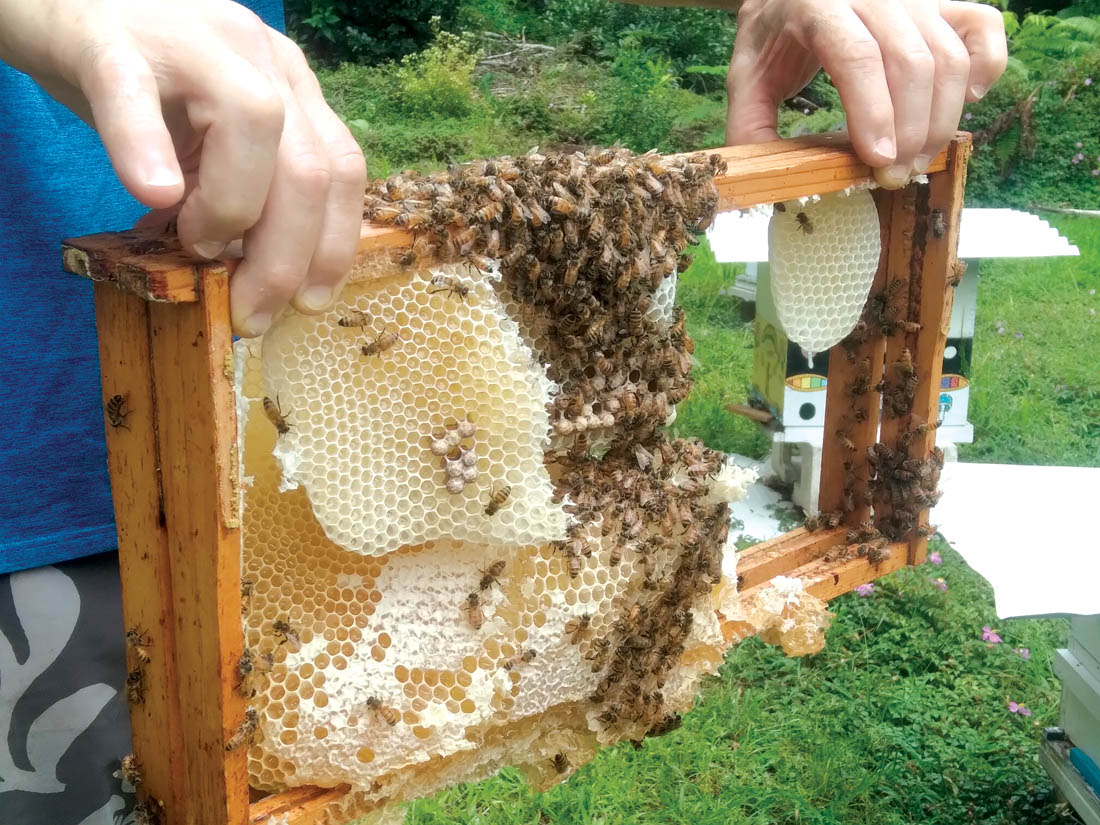
Such a dramatic and protracted loss left her feeling discouraged. On the other hand, the fact that the bees had figured out by themselves ways to mediate the herbicide’s harmful effects came as a glimmer of hope.
“There are certain hives that have fully identified these changes,” Jen says, “and now they’re trying to be proactive to get it out. That to me right there shows an amazing amount of intelligence and awareness.”
Bee Defenders
Harry Holm is the president of the Big Island Beekeepers Association (BIBA). After a few decades of little activity, BIBA began to ramp up its political ambitions partially due to the frustrations felt by small-scale beekeepers like Jen. These days, BIBA rallies support for prospective legislation that offers greater legal protection for beekeepers, including from threats posed by toxic spraying.
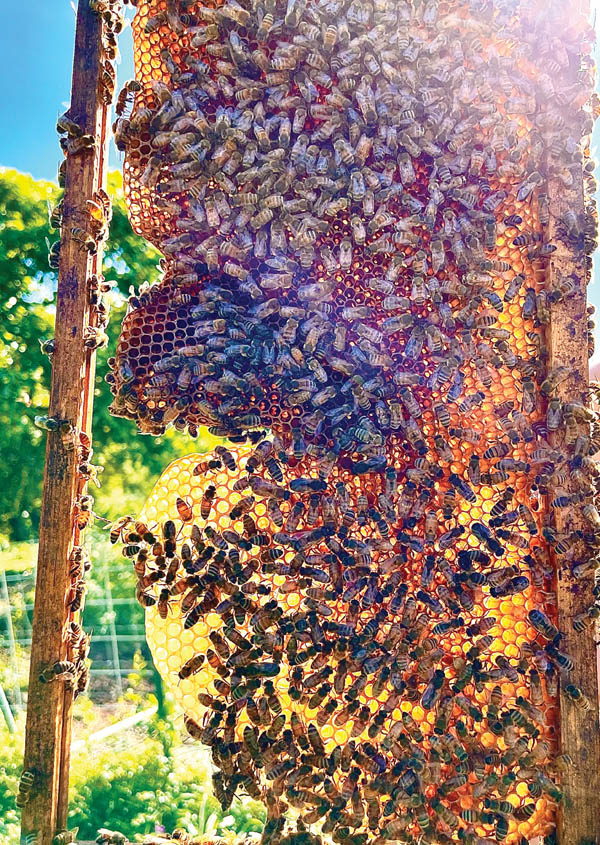
The group is also actively pushing reforms to County of Hawai‘i Ordinances related to beekeeping under the banner of its “Save The Bees Hawai‘i” campaign, which began a few years ago when a BIBA board member’s beehive became the target for the scheming of an unpleasant neighbor. “He ended up having to remove his hive,” Harry recalls, “and there were many others in the neighborhood who had hives, but he’s the only one who got complained about. That’s not right. That’s what kicked us off looking into it.” As the law stands today, honeybees can only be kept on land zoned for agricultural use.
“Our main goal is to make sure that wherever people have bees, that they are compliant with the law,” Harry says. “If you’ve got a hive, and you’re in a commercial or residential area, and you’ve been there for years, you don’t have to worry about a neighbor causing a problem like that.” BIBA recognizes that there are beekeepers here who’ve been operating on non-agricultural land for a long time, and it strives to educate the public and local lawmakers about how their bees benefit the island and how sometimes—like Harry says—they become victims of legal technicality.
After considering the hopes and frustrations of beekeepers like Hope and Jen, and the barriers faced by activists like Harry, it becomes clear that Hawai‘i Island’s bees need real, tangible legal protection. And for an insect which some scientists believe is responsible for 80 percent of the island’s food crop yield, our collective love of papayas, citrus fruits, macadamia nuts, coffee beans, passionfruit, and yes, honey, along with so many other tropical island delicacies, should be all the motivation we need to come to their aid. ❖
For more information:
Hope Anderson: honeybeesensual.com
Jen Rasmussen: facebook.com/buzzon4ever
bigislandbeekeepers.com


